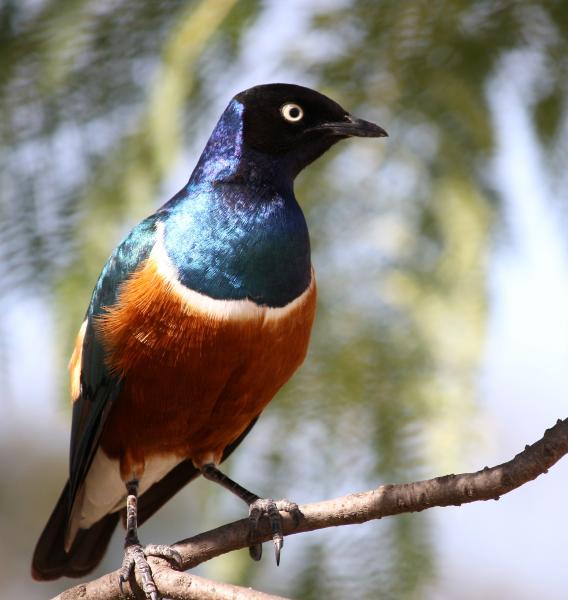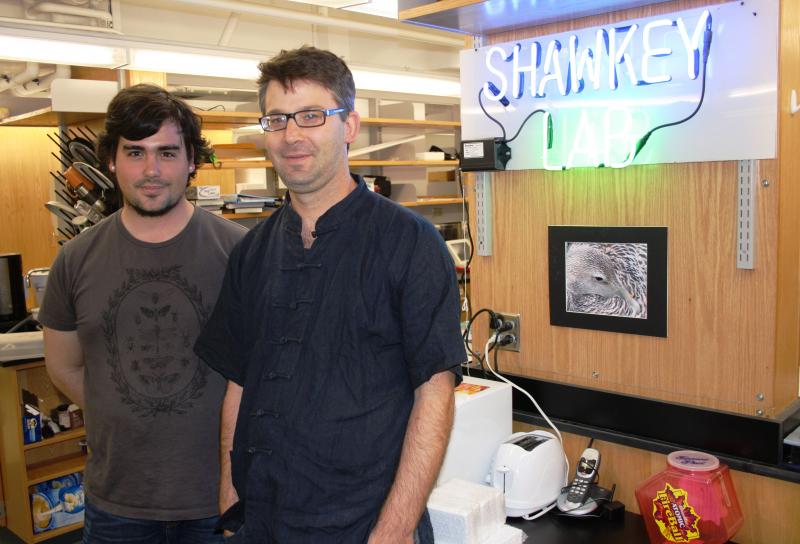Putting the superb in 'superbus'
 The songs of African starlings aren’t the loveliest, but the male’s plumage is stunning. Iridescent blue and violet feathers shine on his neck and back. His belly is carrot orange. It’s no wonder he’s called the ‘superb’ starling. The songs of African starlings aren’t the loveliest, but the male’s plumage is stunning. Iridescent blue and violet feathers shine on his neck and back. His belly is carrot orange. It’s no wonder he’s called the ‘superb’ starling.
In his lab at the University of Akron, researcher Rafeal Maia flips through his collection of African starling feathers. Their Latin names reflect the birds’ brilliance, “Splendus, Superbus, Ornatus…”
Maia snipped hundreds of starling feathers from specimens stored at the American Museum of Natural History in New York and brought them back to Akron to examine.
And what Maia saw, looking at the feathers through an electron microscope, were the unique structures that give them their metallic sheen.
Mix of melanosomes puts evolution in overdrive
All animals have melanosomes.
They give color to our skin and hair, and depending on their structure, a bird’s shimmery iridescence. But Maia says no other animal has the variety of melansomes seen in these feathers.
“These structures have evolved several times in multiple groups of birds, but this particular group of African starlings is the only group that we know of that has evolved all four types.”
The ancestors of today’s starlings reached Africa about 17 million years ago. Back then they had only the simple melanosome type found in most birds.
But Maia says, over time, African starlings evolved three other types of melansomes that allow them to add new colors 10 to 40 times faster than other groups of birds. It’s evolution in overdrive, according to team leader Matt Shawkey.
Seeing evolution in action
The family tree of African starlings was already drawn by other scientists looking at the DNA of interrelated species. Maia then raced back the development of the unique melanosome structures to show how each family in the group evolved. Shawkey says, "this is a way of inferring what we can’t directly see.”
We can’t see evolution happening, but Shawkey says, by tracing back the diversification of the African starling group, we can see how the variety of melansomes led to new color combinations, which led to new species.
 “And so this is a key innovation that enables new kinds of prettiness to evolve, or new kinds of beauty to evolve.” “And so this is a key innovation that enables new kinds of prettiness to evolve, or new kinds of beauty to evolve.”
Shawkey says this is different than the ‘nature, red in tooth and claw,’ process of natural selection.
“You can get new species without the evolution of like a new way to eat something, just a new way of looking good.”
How beauty drives evolution
Besides new ways of eating, or avoiding being eaten, sexual selection also drives evolution. And few animals have exploited the need to impress the opposite sex to the extent seen in birds. Shawkey says that’s how the variety of melanosomes in African starlings opened up new ways for each new species to be beautiful.
“When you get a new type of color producing structure, then you’re going to get a lot of different colors. It’s like adding another crayon to the box.”
The work of Akron's Rafeal Maia and Matt Shawkey, along with Columbia University's Dustin Rubenstein, was published in the most recent edition of the Proceedings of the National Academy of Sciences. |